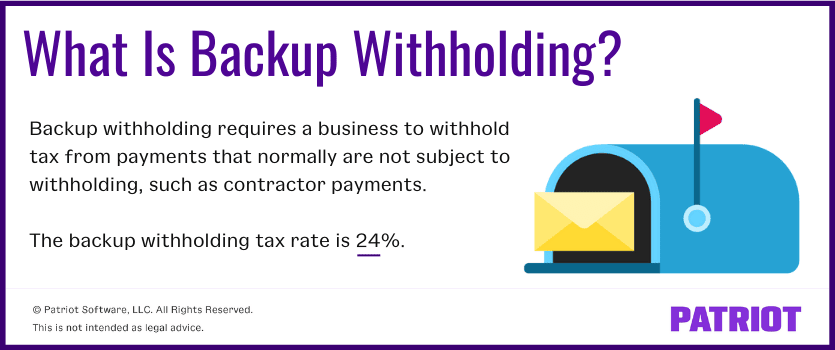When you pay an independent contractor, you don’t withhold taxes from their wages … or do you? In some cases, contractor wages are subject to backup withholding. So, what is backup withholding, and when do you need to do it?
What is backup withholding?
IRS backup withholding requires you to withhold tax from payments that normally are not subject to withholding. Backup withholding is a percentage that ensures the government gets its taxes.
So, how much is backup withholding? How do you know if you need to withhold it? Read on to find out.

What payments are subject to backup withholding?
There are several payment types that the IRS can subject to backup withholding, including:
- Commissions, fees, or other contractor payments
- Attorney’s fees
- Interest payments
- Dividends
- Payment card and third-party network transactions
- Rents, profits, or other gains
- Royalty payments
Whew. That’s a lot of payment types. However, this article focuses on backup withholding on compensation you give to independent contractors.
Is anyone exempt from backup withholding?
Some independent contractors might be exempt from backup withholding. Exempt contractors include:
- Tax-exempt organizations
- Government agencies
- Corporations
For more information on backup withholding exemptions, check out Instructions for the Requester of Form W-9.
How do you know to withhold it?
Individuals who fail to provide a correct taxpayer identification number (TIN) or who fail to report the correct amount of interest and dividends on their tax report may be subject to backup withholding. So, how do you know to withhold it?
When you hire an independent contractor, have the worker fill out Form W-9, Request for Taxpayer Identification Number (TIN) and Certification. Pay close attention to the TIN, which the contractor should include in Part I.
The TIN is a nine-digit number that can be a Social Security number (SSN), an Employer Identification Number (EIN), or an Individual Taxpayer Identification Number (ITIN).
You must begin withholding the tax from a contractor’s wages if the:
- Contractor does not provide a TIN, or if the provided TIN is incorrect, on Form W-9
- IRS sends you a CP2100 or CP2100A Notice that the contractor’s TIN is missing or incorrect
- IRS sends you a C notice that the contractor failed to report or fully report the correct amount of interest and dividend income on their federal income tax return
If you receive a CP2100 or CP2100A Notice, check your records. Did you record the wrong TIN? If not, ask the contractor for a correct TIN (you must make up to three solicitations for the correct TIN—initial, first annual, and second annual).
What is the backup withholding tax rate?
The backup withholding rate is 24%. This means you must withhold 24% of the contractor’s earnings from their wages for taxes for remittance to the IRS.
How do you report and pay backup withholding?
Businesses that pay independent contractors report the payments on Form 1099-NEC, Nonemployee Compensation. This is a normal part of paying contractors. But if you have a contractor whose wages are subject to withholding, you must also use Form 945, Annual Return of Withheld Federal Income Tax.
So, report backup withholding on:
- Form 1099-NEC in box 4 (Federal income tax withheld)
- Form 945, line 2 (Backup withholding)
Deposit the withheld wages throughout the year on either a monthly or semiweekly basis. Your depositing schedule is determined by how much you reported on the previous year’s Form 945.
If you do not follow the backup reporting rules, the IRS can penalize you, and you might be responsible for paying the uncollected amounts out of pocket.
To learn about backup withholding and all your responsibilities, check out the IRS website.
When do I stop backup withholding?
Continue backup withholding until the:
- Contractor provides you with their correct TIN
- IRS notifies you that the contractor is no longer liable for backup withholding
What about state backup withholding?
Some state tax agencies also impose backup withholding. Check with your state tax agency to learn about your state backup withholding responsibilities.
Your rundown on backup withholding responsibilities
Skimmed to the end? Fear not—take a look at the following to help you navigate backup withholding on contractor payments:
- The backup withholding rate is 24%
- Keep an eye out for missing or incorrect TINs on Form W-9 (TINs should have nine numbers)
- Begin withholding the 24% backup withholding rate if the contractor does not provide a TIN, the TIN is incorrect, or the IRS tells you to
- Report the withholding to the IRS
- You can stop backup withholding once the worker gives you a correct TIN or when the IRS tells you to
- Check with your state to determine if the contractor’s earnings are subject to state backup withholding
If you pay independent contractors and need to create Forms 1099 to report the payments, check out Patriot’s accounting software. You can make unlimited contractor payments and print unlimited Forms 1099. Check out the software today for free!
This article has been updated from its original publication date of March 7, 2017.
This is not intended as legal advice; for more information, please click here.



